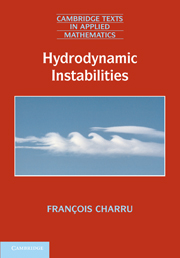Book contents
- Frontmatter
- Contents
- Foreword
- Preface
- Video resources
- 1 Introduction
- 2 Instabilities of fluids at rest
- 3 Stability of open flows: basic ideas
- 4 Inviscid instability of parallel flows
- 5 Viscous instability of parallel flows
- 6 Instabilities at low Reynolds number
- 7 Avalanches, ripples, and dunes
- 8 Nonlinear dynamics of systems with few degrees of freedom
- 9 Nonlinear dispersive waves
- 10 Nonlinear dynamics of dissipative systems
- 11 Dynamical systems and bifurcations
- Appendix A The Saint-Venant equations
- References
- Index
4 - Inviscid instability of parallel flows
Published online by Cambridge University Press: 05 August 2011
- Frontmatter
- Contents
- Foreword
- Preface
- Video resources
- 1 Introduction
- 2 Instabilities of fluids at rest
- 3 Stability of open flows: basic ideas
- 4 Inviscid instability of parallel flows
- 5 Viscous instability of parallel flows
- 6 Instabilities at low Reynolds number
- 7 Avalanches, ripples, and dunes
- 8 Nonlinear dynamics of systems with few degrees of freedom
- 9 Nonlinear dispersive waves
- 10 Nonlinear dynamics of dissipative systems
- 11 Dynamical systems and bifurcations
- Appendix A The Saint-Venant equations
- References
- Index
Summary
Introduction
An instability typical of a parallel flow was demonstrated in an experiment performed by Osborne Reynolds (1883) and repeated by Thorpe (1969). A horizontal long tube is filled carefully with a layer of water lying on top of a layer of heavier colored brine (salt water), as sketched in Figure 4.1a. The tube is suddenly tipped several degrees: the brine falls and the water rises, creating a shear flow which displays an inflection point near the interface (Figure 4.1b). In a few seconds a wave of sinusoidal shape develops at the interface of the two fluids, and leads to regular co-rotating vortices, as shown in Figure 4.2. These vortices are a manifestation of the Kelvin–Helmholtz instability. This instability owes its origin to the inertia of the fluids; viscosity plays only a minor role, tending to attenuate the growth of the wave only slightly by momentum diffusion.
Another manifestation of the Kelvin–Helmholtz instability on a much larger atmospheric scale is illustrated in Figure 4.3. An upper air layer flows over a lower layer moving more slowly, with different humidity and temperature. The thin layer of clouds formed at the interface displays billows which are the exact analogs of those in Figure 4.1. Figure 4.4 shows another example, in a mixing layer formed between a flow of water on the left and a flow of water and air bubbles on the right.
- Type
- Chapter
- Information
- Hydrodynamic Instabilities , pp. 104 - 138Publisher: Cambridge University PressPrint publication year: 2011



